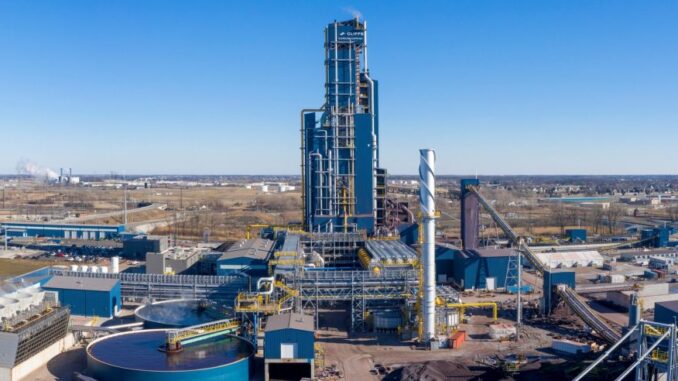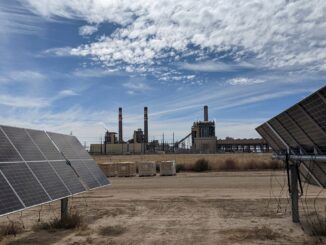
Ohio-based Cleveland-Cliffs’ success in beating its goal to cut greenhouse gas emissions from its U.S. iron and steel operations won recognition from the Department of Energy last month.
The progress is part of a broader industry trend to cut pollution that drives human-caused climate change. Yet advocates say there’s lots of room for further cuts.
Cliffs slashed greenhouse gas emissions for almost four dozen U.S. facilities by nearly one-third from a 2017 baseline as of the end of last year. As a result, the Department of Energy named the company a 2023 Goal Achiever in the agency’s Better Climate Challenge.
The steel industry was responsible for about 7% of global carbon dioxide emissions as of 2020, the U.S. Energy Information Administration reported last year. That’s roughly one-sixth of all worldwide emissions from generating power, according to a Canary Media analysis of the International Energy Agency data. The iron and steel industry led the industrial sector, with the cement industry coming in second.
The achievement and ongoing decarbonization efforts by Cliffs and other companies stand out because the steel industry has been seen as a hard-to-decarbonize sector, due to its need for high heat and continuous operations, as well as process reactions that emit more carbon dioxide.
At the same time, the energy transition and growth of renewable energy will likely increase demand for steel, and global demand for low-carbon steel should grow as well, according to a McKinsey & Company analysis released earlier this year. Companies in the steel industry also see a need to curb emissions in order to limit the worst impacts of climate change.
“We do know that we play a role in global warming,” said Traci Forrester, executive vice president for environmental and sustainability matters at Cliffs.
Added incentives come from the prospect of possible government regulation of carbon emissions in order to address climate change, as noted in the company’s 2022 annual report to shareholders, released this past April.
Customer demands also play a role. “At U.S. Steel, it’s not just about reducing our own carbon footprint,” said Arista Joyner, who manages financial and sustainability communications for that company. “We must adapt to the changing needs of our customers and their sustainability goals too.”
The traditional method of making steel mixes iron ore in a blast furnace with a high-carbon form of coal, called coke. The carbon combines with oxygen in the ore to form carbon dioxide. The iron melts. Other leftover waste takes the form of slag.
The iron — called “pig iron” at this stage — is then sent to a second furnace that blows in oxygen to make steel from the iron and some other elements. That also releases greenhouse gas emissions.
Together, the two steps account for nearly three-fourths of the U.S. iron and steel industry’s carbon dioxide emissions, according to RMI, a nonprofit whose work focuses on decarbonization.
Much of Cliffs’ progress on emissions is thanks to the 2020 opening of its “direct reduction” plant in Toledo. The facility starts with pelletized iron ore, which comes primarily from Minnesota, where a preliminary baking process has already removed some impurities.
Direct reduction removes oxygen from the ore with reformed methane, which is basically a combination of carbon monoxide and hydrogen. Both the hydrogen atoms and the carbon monoxide molecules can combine chemically with the oxygen. So, direct reduction is a lower-carbon way to process the ore pellets. The plant’s output is hot briquetted iron.
The Toledo plant has not eliminated the company’s use of blast furnaces. But hot briquetted iron can reduce the amount of coke needed if its next stop is a blast furnace, Forrester said. Transporting the briquettes while they’re hot also cuts down on fuel needs there or for the oxygen process furnace.
Hot briquetted iron can also go into an electric arc furnace. The steel industry mainly uses those furnaces now to recycle scrap steel.
“The beauty of steel is that it’s infinitely recyclable,” said Rich Freuhauf. The senior vice president and chief strategy and sustainability officer for U.S. Steel spoke at a Reuters Industry Transition conference in September.
Recycling eliminates the need to repeat the carbon dioxide-releasing steps of refining iron ore. And, as the name implies, electric arc furnaces run on electricity. So they could use nuclear power or renewable energy with battery storage instead of fossil fuels.
But recycled steel from electric arc furnaces won’t necessarily satisfy all the forecast demands for steel. Nor does it yet meet the requirements for some higher-grade or specialty types of steel. Those include higher-strength steel and high-ductility steel, which can be formed into different shapes, such as the exposed panels on automobiles.
“That’s really our niche in servicing the automotive market, in addition to many other markets,” Forrester said. Some carbon content can also help achieve different properties in steel.
Cliffs’ emissions cuts also reflect energy efficiency improvements throughout its facilities, Forrester said. And there’s room for more emissions reductions.
Cliffs is part of the Midwest Alliance for Clean Hydrogen. Assuming acceptable agreements can be negotiated with the agency, the coalition stands to get up to $1 billion in hydrogen hub funding, the Department of Energy announced last month.
The hub could help supply Cliffs’ Indiana Harbor and Burns Harbor plants. Hydrogen would likely be blended with natural gas at first, Forrester said. Then, if all goes well, hydrogen could substitute for more or potentially all of the fossil fuel.
Cliffs also was part of the Great Lakes Clean Hydrogen Hub Coalition, which proposed making so-called “pink hydrogen” with excess electricity at the Davis-Besse nuclear plant in Ohio. Although DOE did not pick the project for a regional hydrogen hub award, the Energy Harbor plant has been working on hydrogen production for several years. Spokesperson Todd Morgano said the project “is scheduled to be operational by spring of 2024.”
The steel industry has also been buying more renewable energy. Last December, for example, Cliffs agreed to a 15-year power purchase agreement with EDP Renewables for 180 megawatts of power from a wind farm in Indiana near the Ohio border. State laws passed in 2014 and 2021 make it extremely difficult to site new commercial wind farms in Ohio.
Carbon capture utilization and storage, or CCUS, could also curb the steel industry’s emissions, although its feasibility hasn’t been proven yet.
“While carbon capture technologies exist and are widely adopted in the oil and gas realm and some other industries, carbon capture has never been done with blast furnace gas,” Forrester said. Cliffs has multiple facilities near areas with suitable geologic formations for storing the waste carbon dioxide, she noted.
Other research is exploring whether carbon might be further cut or eliminated from the ore-processing stages. In June, the Department of Energy announced nearly $32 million in funding for projects to decarbonize iron and steel.
One of the 10 projects that won funding, led by Cleveland’s Case Western Reserve University, would use an electric current with molten salt to strip oxygen from iron ore. Case Western is also among the partners for the Center for Steel Electrification by Electrosynthesis, headed by Argonne National Laboratory in Lemont, Illinois.
“From our standpoint, Cleveland-Cliffs has been a good actor to date,” said Nick Yavorsky, an RMI industry analyst who co-authored a September report on opportunities for making near-zero-emissions steel in the Great Lakes region. But, he added, “now we have to look at the big stuff.”
While hydrogen could potentially power all of a direct reduction plant, there are limits on how much could be blended with coal at a blast furnace, he said. Further big cuts would likely call for retiring coal-burning blast furnaces and replacing them with more direct reduction plants. Yavorsky said he also thinks most specialty steel products could be made in electric arc furnaces run on renewables or nuclear power with hot briquetted iron.
Ohio policymakers could support investments to achieve those shifts, including through existing programs for JobsOhio, said Lachlan Carey, an RMI policy analyst and economist who also worked on the September report. Supporting green steel could increase the state’s steel industry employment, while also enhancing Ohio’s ability to attract other manufacturing jobs where companies want access to clean energy, he said.
U.S. Steel has already committed to net-zero greenhouse gas emissions by 2050, Freuhauf said. Cliffs has so far shied away from that.
“We take a very practical approach to reducing greenhouse gases and the statements and promises that we make,” Forrester said, adding that while the company has aspirations, it focuses on what it knows it can achieve. “We take action on what we can today,” she said.



